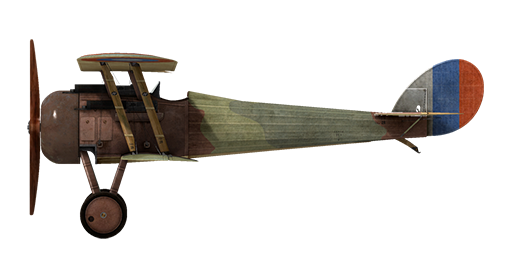il2
Nieuport 28.C1

Description
The next evolution in the line of fighters made by Nieuport S.A.d E. (Societe Anonyme des Etablissements) Company was the Nieuport 28. Its designers knew that their previous designs were now obsolete and did not allow for better flight characteristics. Therefore, it was decided to use structural features of the SPAD XIII in the design of the new fighter. Some of these features are as follows: larger surface area of the lower wing (a second spar was fitted to it, thus making it a true biplane); a second machine gun was placed left of the centreline behind the engine; and ailerons were fitted to the lower wing instead of the top wing. Its first trial flight occurred on June 5, 1917. Unfortunately, the new fighter could not exceed the flight characteristics of the already-employed SPAD XIII. As a result, French pilots refused to fly it. In all, 208 fighters of this type were built, after which the Nieuport S.A.d E. Company switched to manufacturing the SPAD XIII.
The Nieuport 28 entered service with American squadrons in February 1918. Due to an insufficient supply of Vickers machine guns, combat use of the fighter did not begin until the following month. It was primarily used for engaging enemy fighters and balloons but rarely for bomber escort or recon missions behind enemy lines. Pilots noted good climb speed, manoeuvrability, and the sensitivity of its controls. In the course of its combat service, it was found that the plane tended to lose its top wing covering in prolonged dives. There were several incidents of this described by pilots who managed to land despite experiencing such severe damage.
Engine
rotary 9 cyl. Gnome 9N 160 hp
Dimensions
Height: 2500 mm
Length: 6400 mm
Wing span: 8160 mm
Wing surface: 20 sq.m
Weight
Empty: 436 kg
Takeoff: 698 kg
Fuel capacity: 125 l
Oil capacity: 25 l
Maximum airspeed (IAS)
sea level — 203 km/h
1000 m — 190 km/h
2000 m — 177 km/h
3000 m — 165 km/h
4000 m — 150 km/h
5000 m — 136 km/h
Climb rate
1000 m — 2 min. 43 sec.
2000 m — 5 min. 43 sec.
3000 m — 9 min. 30 sec.
4000 m — 14 min. 49 sec.
5000 m — 23 min. 20 sec.
Service ceiling 5800 m
Endurance at 1000m
nominal power (combat) — 1 h. 10 min.
minimal consumption (cruise) — 1 h. 10 min.
Armament
Forward firing: 2хVickers Mk.I 7,69mm, 250 rounds per barrel.
References
1) The Nieuport 28 America's first fighter. Theodore Hamady.
2) The Nieuport 28 C.1. Profile Publications Number 79.
3) Nieuport 28 by J Guttman. Windsock Datafile 36.
Modifications
Anemometer
E.Badin Anemometer (70..200 km/h at 2000 m and 80..220 km/h at 4000 m)
Additional mass: 1 kg
Balloon guns
Twin Vickers “Balloon” guns
Ammo: 300 of 11.43mm rounds
Projectile weight: 17,5 g
Muzzle velocity: 610 m/s
Guns weight: 26 kg
Ammo weight: 24 kg
Rate of fire: 600 rpm
Total additional weight of weapon modification: 50 kg
Sideslip Indicator
Sideslip indicator (ball-type)
Additional mass: 1 kg
Compass
L.Maxant Compass
Additional mass: 1 kg
Altimeter
Peltret and Lafage Altimeter (0..5000m)
Additional mass: 1 kg
Aldis
Aldis Refractor-type Collimator Sight (imported from Britain)
Additional mass: 2 kg
Le-Chretien
Le-Chretien Refractor-type Collimator Sight
Additional mass: 1 kg
Cockpit light
Cockpit illumination lamp for night sorties
Additional mass: 1 kg
Clock
Mechanical Clock
Additional mass: 1 kg